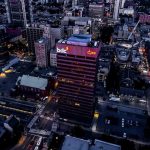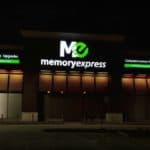
Light up building signs with LEDs
The Hamilton Spectator signage — retrofitted to LED. (Photo: LED Solutions)
Commercial and institutional building owners with outdoor signage can be assured of reduced energy costs by replacing or retrofitting their broken and inefficient neon signs with light-emitting diode lamps (LEDs). LEDs are solid-state devices that convert electric energy directly into.
Commercial and institutional building owners with outdoor signage can be assured of reduced energy costs by replacing or retrofitting their broken and inefficient neon signs with light-emitting diode lamps (LEDs). LEDs are solid-state devices that convert electric energy directly into light of a single colour. Because they employ “cold” light generation technology in which most of the energy delivered is in the visible spectrum, LEDs do not waste energy in the form of non-light producing heat. They also have greater resistance to shock, vibration, and wear, and exceptionally long operational lives, making them ideal for such outdoor applications as illuminated signs.
LEDs are an environmentally friendly option. According to the IFMA Foundation Sustainability How-To Guide on Lighting Solutions, a single kWh of electricity will generate 0.6 kg of CO2 emissions. Assuming the average light bulb is on for 10 hours a day, a single 40 watt incandescent bulb will generate 89 kg of CO2 every year. The electricity needed to operate a 13 watt LED equivalent will result in the emission of 29 kg of CO2 over the same time span. A building’s carbon footprint from lighting can be reduced by 68 percent by exchanging all incandescent bulbs for new LEDs.
Retrofitting a neon sign with LED modules can save even more. The Hamilton Spectator had their signage retrofitted from neon to LED. The change was made from 58.67 metres of neon with a total wattage of 2310 to 770 LED modules with a total wattage of 569.9. The hydro rate was reduced from $1,102 to $249 per year, resulting in efficiency savings of 75.33 percent and cost savings of $762.21 per year. In addition, the sign is brighter, with even light distribution, and could be maintenance free for a period of approximately seven to 10 years.
Read more about LEDs and other forms of energy efficient lighting in the NRCan Lighting Reference Guide. Read Technical Fact Sheets about lighting and lighting controls on the OEE Buildings Division Web site. Find a lighting systems contractor and other energy service providers by searching the OEE Energy Management Services Directory.
This article was originally published in the Hamilton Spectator.





